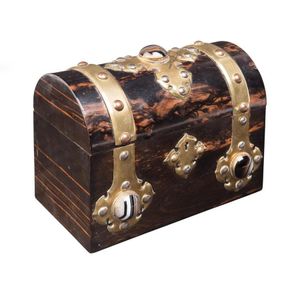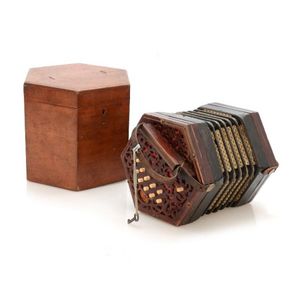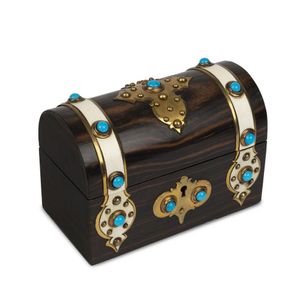1860 English Jewellery Casket with Rhinestone Decoration
An antique English jewellery casket with domed top, coromandel and ivory with gilt metal mounts and rhinestone decoration, circa 1860, 11.5 cm high, 17 cm wide, 9 cm deep
You must be a subscriber, and be logged in to view price and dealer details.
Subscribe Now to view actual auction price for this item
When you subscribe, you have the option of setting the currency in which to display prices to $Au, $US, $NZ or Stg.
This item has been sold, and the description, image and price are for reference purposes only.
- Calamander / Coromandel - Calamander wood, also known as coromandel wood or coromandel ebony, is a type of hardwood that comes from the Calamander tree (Diospyros quaesita), which is native to Sri Lanka, India, and Southeast Asia. The wood is known for its dark brown or black colour and its distinctive figuring, which can resemble a snakeskin pattern.
The wood is highly prized for its beauty and durability. It is often used in fine furniture making, particularly in the production of inlaid and marquetry work, as well as in the making of boxes, cabinets, and other decorative items. It is also used in the manufacture of flooring, paneling and other architectural applications.
Calamander wood is a very hard and heavy wood, it has a density of around 1.04 g/cm3. Its density and high natural oil content make it resistant to decay and insects, which is why it is a popular choice for outdoor furniture, flooring and other decorative items.
The wood is also used for turning and carving, but is difficult to work due to its high density and interlocking grain. However, it takes a high natural polish and has a beautiful lustre, which is why it is so sought after.
Due to the high demand and over-exploitation of the natural resources, the calamander tree is now a protected species, and the harvesting and export of the wood is heavily regulated. - Ivory - Ivory is a hard white material that comes from the tusks of elephants, mammoth, walrus and boar, or from the teeth of hippopotamus and whales. The ivory from the African elephant is the most prized source of ivory. Although the mammoth is extinct, tusks are still being unearthed in Russia and offered for sale.
Ivory has been used since the earliest times as a material for sculpture of small items, both in Europe and the east, principally China and Japan.
In Asia ivory has been carved for netsuke, seals, okimono, card cases, fan supports, animals and other figures and even as carved tusks.
In the last 200 years in Europe ivory has been used to carve figures, for elaborate tankards, snuff boxes, cane handles, embroidery and sewing accessories, in jewellery and as inlay on furniture. Its more practical uses include being used for billiard balls, buttons, and a veneers on the top of piano keys.
The use and trade of elephant ivory have become controversial because they have contributed to Due to the decline in elephant populations because of the trade in ivory, the Asian elephant was placed on Appendix One of the Convention on International Trade in Endangered Species (CITES), in 1975, and in January 1990, the African elephant was similarly listed. Under Appendix One, international trade in Asian or African elephant ivory between member countries is forbidden. Unlike trade in elephant tusks, trade in mammoth tusks is legal.
Since the invention of plastics, there have been many attempts to create an artificial ivory - Circa - A Latin term meaning 'about', often used in the antique trade to give an approximate date for the piece, usually considered to be five years on either side of the circa year. Thus, circa 1900 means the piece was made about 1900, probably between 1895 and 1905. The expression is sometimes abbreviated to c.1900.
- Diamante / Rhinestone - A diamante and a rhinestone are both imitation diamonds made from glass, rock crystal or acrylic. Originally rhinestones were rock crystals mined from the Rhine river Rhine in the 18th century, but the term is now associated with any imitation diamonds. Diamantes and a rhinestones are used in costume jewellery, in clothing and accessories, and were especially popular in the 1930s,
This item has been included into following indexes:
Visually similar items

A fine quality agate mounted bronze and coromandel casket, French, 19th century, 18 cm high, 22 cm wide, 12 cm deep
Sold by
in
for
You can display prices in $Au, $US, $NZ or Stg.

Decorative antique box, with metal music motifs, 10.5 cm x 26 cm, 9 cm high
Sold by
in
for
You can display prices in $Au, $US, $NZ or Stg.

A 19th century coromandel jewellery box
Sold by
in
for
You can display prices in $Au, $US, $NZ or Stg.

English Lachen & Co button Accordian. Wooden case. Appears functional.
Sold by
in
for
You can display prices in $Au, $US, $NZ or Stg.
